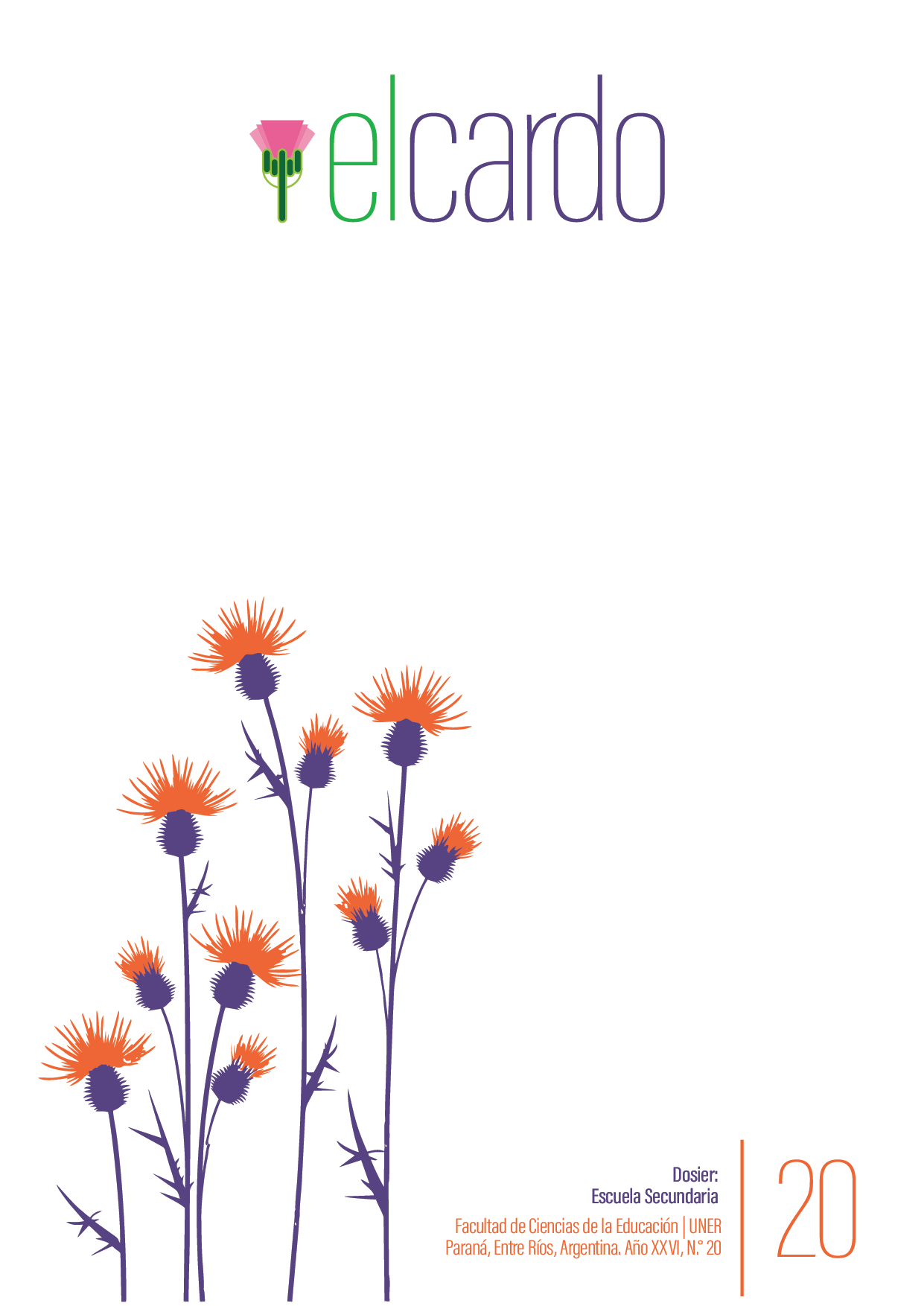Los escenarios combinados del año 2021: la clase escolar en el multiverso del nivel secundario
Contenido principal del artículo
Resumen
Durante el segundo cuatrimestre del año 2021, la educación secundaria de Argentina, se sostuvo en un ecosistema de medios digitales y tecnologías analógicas, con estudiantes que asistían alternadamente a la escuela. Esto significó la división del grupo clase, mientras unos estudiantes asistían de manera presencial a las aulas, otros lo hacían de manera virtual. Para ambos grupos debían diseñarse propuestas de aprendizaje respetuosas de sus trayectos, y asegurar la enseñanza combinando las posibilidades de la presencialidad offline y la disposición online en las escuelas. Cada escenario se constituye como antagónico al otro, con reglas determinadas, parámetros de acción que escapan a los mismos actores y demandas diferentes que alentaban a la construcción de clases alternativas y múltiples. La variabilidad, singularidad y desafíos didácticos, es analizada en esta comunicación a partir de las voces de docentes de nivel secundario de escuelas técnicas y comunes de Argentina, recuperadas a partir de entrevistas en el marco del proyecto “La reconfiguración de las desigualdades vinculadas a la educación secundaria argentina en situación de pandemia/postpandemia” (PISAC – COVID-19). El análisis nos permite identificar que, la sobre exigencia de los docentes a atender didáctica y pedagógicamente dos grupos de estudiantes en condiciones diferentes, les permitió una revisión de sus clases, corrección y reconocimiento de las nuevas formas que asumió la enseñanza. Sin embargo, aunque la teoría pueda concluir en que los entornos digitales son gratificantes, placenteros y enriquecedores, la enseñanza en estos escenarios no se corresponde bajo estas sensaciones. Las condiciones y requerimientos de educabilidad que exigían las instituciones escolares terminaron por tensionar las posibilidades reales de los docentes para sostener ambos trayectos.
Descargas
Detalles del artículo

Esta obra está bajo una licencia internacional Creative Commons Atribución-NoComercial-CompartirIgual 4.0.
Las ediciones no tienen cargos para las y los autores ni para las y los lectores, y se incita a las y los autores a depositar sus contribuciones en otros repositorios institucionales y temáticos, con la certeza de que la cultura y el conocimiento son un bien de todos y para todos. El Cardo permite la reutilización luego de su edición (Post print) citando la autoría y la fuente original de su publicación. Su uso no puede ser con fines comerciales.
Citas
Alonso, L. (2015). Multiverso. Entre el rigor de la matemática y la fantasía científica. Investigación y Ciencia, 461.
Area, M. (2017). Area Moreira, M. (2017) La metamorfosis digital del material didáctico tras el paréntesis Gutenberg. RELATEC, 16(2) 13-28 http://dx.medra.org/10.17398/1695-288X.16.2.13
Arroyo, M.; Corvala, T.; Felicioni, S.; Merodo, A. (2021). Enseñanza, desigualdades y reconfiguración del trabajo docente en escuelas secundarias durante la pandemia. Itinerarios Educativos, I(14), 17-29. DOI: https://doi.org/10.14409/ie.2021.14.e0003
Baricco, A. (2019). The Game. Anagrama
Bauman, Z. (2015). Dilemas del vecino contemporáneo. Revista Ñ. https://www.clarin.com/ideas/zygmunt-bauman-dilemas-vecino-contemporaneo_0_BkMxIKQFPQe.html
Consejo Federal de Educación (1 de setiembre de 2020). Resolución N° 366/20. https://www.argentina.gob.ar/sites/default/files/res_366_if-2020-57962200-apn-sgcfeme.pdf
Eisner, E. (1998) Cognición y curriculum. Anagrama
Gálvez Leyva, J. M. (2022). Metaverso: cuando la realidad supera a la ficción. +Ciencia, (28), 16–18. https://revistas.anahuac.mx/masciencia/article/view/1234
Litwin, E. (1997). Las configuraciones didácticas. Paidós.
Maggio, M. (2021). Educación en Pandemia. Paidós.
Mares. L. (dir.) (2021). Escenarios combinados para enseñar y aprender: escuelas, hogares y pantallas. Educ.ar.
Meta. (2022). ¿Qué es el metaverso? Meta. https://about.meta.com/ltam/what-is-the-metaverse/
Monserrat, J. (2011). La obra de Hawking confirma el enigma metafísico del universo. Pensamiento 67(254), 1133-1145. https://revistas.comillas.edu/index.php/pensamiento/article/view/1622
Sagol C. (coord.) (2021). Escenarios combinados para enseñar y aprender. Ministerio de Educación de la Nación. Buenos Aires.
Santucci, P. (2022). Sección 1. Formato de la escuela secundaria y virtualización de la educación en la pandemia. En: Causa, M.; Di Piero, E. y Santucci, P. (Comps.) Educación secundaria, desigualdad, pandemia horizontes pospandemia, pp. 27-32. Puntoaparte. https://www.memoria.fahce.unlp.edu.ar/libros/pm.5503/pm.5503.pdf
Scolari, C. (2010). Ecología de los medios. Mapa de un nicho teórico. Quaderns del CAC, 34(XIII), 17-25
Scolari, C. (2015). Ecología de los medios. Entornos, evoluciones e interpretaciones. Gedisa.
Scolari, C. (2019). Baricco Strikes Back. Hipermediaciones. https://hipermediaciones.com/2019/02/17/baricco-strikes-back/
Souto, M. (1997). La clase escolar. Una mirada desde la didáctica de lo grupal. En Camilloni, A.; Davini, M.; Edelstein, G.; Litwin, E.; Souto,
M.; Barco, S., Corrientes didácticas contemporáneas, pp. 117-156. Paidós.
Steinman, J. (2018). Las prácticas de la enseñanza - en análisis desde una didáctica reflexiva. Miño y Dávila.
Stephenson, N. (1992). Snow Crash. Gigamesh
Van Dijck, J. (2016). La cultura de la conectividad. Siglo XXI

